Features
Sri Lanka’s Foreign Policy amid Geopolitical Transformations: 1990-2024 – Part V
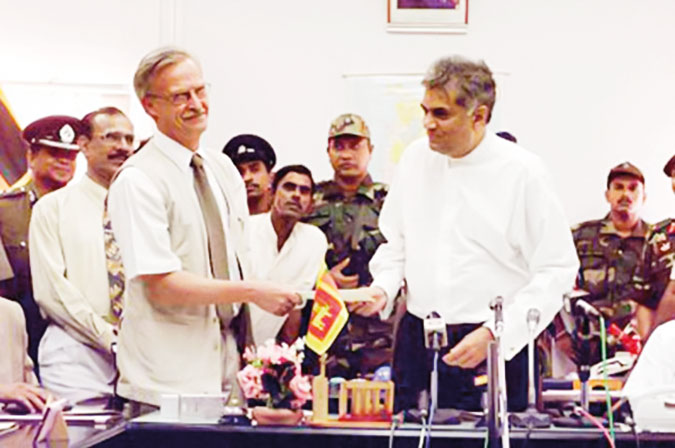
Foreign Policy and Peace process under Prime Minister Ranil Wickremesinghe
Soon after Ranil Wickremesinghe became the Prime Minister following the snap parliamentary elections in December 2001, the Liberation Tigers of Tamil Eelam (LTTE) unilaterally declared a ceasefire. The newly formed the United National Front (UNF) government under the leadership of the Prime Minister responded positively to this gesture of goodwill. On February 22, 2002, the government and the LTTE signed the Ceasefire Agreement (CFA). As part of the agreement, an International Monitoring Mission was established to oversee and ensure the implementation of the ceasefire.
The shift in the international situation, particularly following 9/11, played a crucial role in compelling the LTTE to agree to a ceasefire and enter negotiations with the Sri Lankan Government. By this time, the LTTE had already been designated as a terrorist organisation by several countries. In this context, continuing the war posed significant risks, with potential consequences that the LTTE would likely be unable to withstand. The changing demographics of the North and East posed a significant challenge to the LTTE. The mass exodus of Tamils from these regions led to the migration of approximately 500,000 Tamils abroad, while an additional 200,000 relocated to the south of Sri Lanka. As a result, the Tamil population, which had constituted 12% of the total population at the onset of the conflict, was reduced to just 8% (Smith, 2003). Another crucial factor was the rise of a pro-LTTE Tamil business community—comprising professionals and entrepreneurs operating internationally. These individuals were far more attuned to global political shifts and pressures, making them more responsive to international dynamics.
The hastily inked UNF-LTTE Ceasefire Agreement had several significant weaknesses. Many of these could have been avoided had the Government of Sri Lanka (GOSL) engaged in more careful pre-ceasefire agreement bargaining with the LTTE, instead of rushing to sign the agreement. It granted numerous concessions without receiving any reciprocation. Additionally, the agreement lacked a clear time frame and established an open-ended ceasefire without committing to a political settlement. These flaws hindered the progress of negotiations.
After six rounds of talks, the LTTE unilaterally withdrew from peace negotiation in April 2023. Despite repeated efforts by Norwegian facilitators, supported by Japan and other international stakeholders, to bring the LTTE back to the table, all attempts failed. The LTTE adamantly refused even to attend the Tokyo Conference on Reconstruction and Development of Sri Lanka (Tokyo Aid Confab) to be held in June 2003.
It was clear that the peace process with international facilitation was frozen on the brink. Meanwhile, the LTTE maneuvered the UNF government to present three sets of proposals for an interim arrangement one after another and rejected them all. At this point, the LTTE presented its own proposal for an Interim Self-Governing Authority (ISGA) and insisted that any future peace discussions be based on it. The sharp political brinkmanship of LTTE in the face of naivety of the UNF Government was clearly evident by the way the ISGA was presented and made it to be a condition for any future peace talks. In November 2023, when the peace process reached an impasse, President Kumaratunga exercised her executive power to dissolve Parliament, effectively ending the UNF-led peace process. The final attempt to revive the stalled peace talks by the Norwegian facilitators led to the Geneva talks in February 2006 to realize that both sides were no longer willing to politically invest in the negotiations.
Sri Lanka’s foreign policy under the UNF government, (December 2001- November 2013, largely shaped by Prime Minister Ranil Wickremesinghe, was primarily focused on facilitating peace negotiations with the LTTE. The country’s international relations were predominantly framed around these negotiations, with diplomatic efforts concentrated on garnering both regional and global support for the peace process.
Eelam War-IV and Foreign Policy
Sri Lanka’s domestic political landscape underwent a profound transformation following the parliamentary elections on April 2, 2004, which saw the rise of Mahinda Rajapaksa to the position of Prime Minister. By now, the peace process initiated by Prime Minister Ranil Wickremesinghe with international mediation was stuck in limbo. The LTTE’s intransigence became apparent as efforts by international facilitators and other stakeholders to revive peace talks repeatedly faltered. Simultaneously, a tide of Sinhala nationalist forces, with some vocal Buddhist monks playing a prominent role, gained increasing prominence. This political wind in the South was particularly evident in the strong opposition to the Post-Tsunami Operational Management Structure (P-TOMS) presented by President Kumaratunga. The gulf between the LTTE and the Government was intensified following the assassination of Foreign Minister Lakshman Kadirgamar by the LTTE. Against this backdrop of growing instability, Mahinda Rajapaksa, backed by Sinhala nationalist forces, won the presidential election on November 17, 2005, defeating Ranil Wickremesinghe.
When Mahinda Rajapaksa became President, the ceasefire was just limited to a paper, presenting no obstacle to military action between the parties. The violence had escalated to full-scale war, marking the beginning of Eelam War IV in August 2006. From the very beginning, the winds on the battlefield blew decisively in favour of the GOSL forces. After acquiring the territory in the Eastern province controlled by the LTTE in September 2007, the GOSL forces embarked on the second phase of its military offensive against the LTTE in the Mannar District in the Northern Province. In the face of the advancing GOSL forces, the territory held by the LTTE in the Wanni area contracted rapidly confining it to a narrow strip of land in the Mullaitivu district.
During Eelam War IV, international opinion turned against the LTTE, largely due to the global backlash against terrorism following 9/11. The group’s designation as a terrorist organisation by multiple countries severely hindered its operations, particularly in fundraising, arms trafficking, and recruitment. Additionally, the second generation of the Tamil diaspora, more attuned to evolving social and political dynamics, became less willing to jeopardize their stability and future for the LTTE.
After the collapse of all LTTE military strongholds, the LTTE sought to create a humanitarian crisis that they believed would prompt international intervention. They hoped this would eventually lead to the establishment of a transitional authority under UN supervision, followed by a plebiscite within a specified timeframe. To set this scenario in motion, the LTTE took over 250,000 ordinary people, planning to hold them until the situation unfolded as expected. The LTTE was convinced until the last moment that these Tamil civilians would stay with them. However, once the GOSL forces broke the siege, the civilians abandoned the LTTE, leaving them vulnerable to attack. The total military defeat of the LTTE at the Nanthikadal lagoon marked the dramatic end of nearly three decades of armed conflict in May 2009.
Sri Lanka’s foreign policy during the Eelam War IV was primarily focused on managing international pressure and addressing India’s concerns. International Non-Governmental Organizations (NGOs) regularly issued reports highlighting human rights violations committed by both sides of the conflict. In September 2008, there was an attempt to broker a ceasefire through the UN. However, the Government of Sri Lanka (GOSL) stood firm in its demand for the total surrender of the LTTE (Salter, 2015: 324). In response to mounting international pressure over civilian casualties, the government declared the establishment of a “No Fire Zone” on January 21, 2009. Five days later, UN Secretary-General Ban Ki-moon met with Minister Basil Rajapaksa in New York, expressing deep concern over the humanitarian situation in the Wanni. He urged both parties to respect the No Fire Zone and facilitate the movement of civilians out of the conflict zone.
The Sri Lankan government failed to recognise that international concern extended beyond the LTTE to the plight of civilians trapped in conflict zones. It frequently accused international non-governmental organizations (INGOs) of being pro-LTTE, alleging they were influenced by the pro-LTTE Tamil Diaspora. During the final stage of Eelam War IV, the co-chairs of the Sri Lankan peace process—the European Union, Japan, Norway, and the United States—issued a statement urging an end to shelling in the no-fire zone. They called on the LTTE to negotiate an end to hostilities, surrender arms, renounce violence, accept an amnesty, and participate in a political process for a lasting solution. However, the Sri Lankan government viewed this as an attempt to protect the LTTE and rejected the co-chairs’ ceasefire proposal. As a result, the Co-Chairs found themselves with few viable options—trapped between Scylla and Charybdis.
Another critical factor that emerged in the final stage of the war was India’s role. From the outset of the ethnic conflict, the LTTE maintained a strong presence in Tamil Nadu. However, the assassination of Rajiv Gandhi in May 1991 dramatically altered the political landscape, leading both the DMK and AIADMK—the two major political parties in Tamil Nadu—to distance themselves from the LTTE. The situation shifted again with the onset of Eelam War IV. A key turning point was the Sri Lankan airstrike on the Sencholai orphanage on 14 August 2006, which triggered widespread public outcry in Tamil Nadu. As D.B.S. Jeyaraj (2008) observed, the public unrest during this period should not be mistaken for support for the LTTE. Rather, it reflected the deep concern of Tamil Nadu’s 70 million Tamils for their ethnic counterparts across the Palk Strait.
In late 2008, the situation in Sri Lanka significantly influenced Tamil Nadu politics. In response to mounting pressure from Tamil Nadu, the Indian National Security Advisor, M.K. Narayanan, summoned the Sri Lankan Deputy High Commissioner to express India’s deep concern and dissatisfaction over the rising number of Tamil civilian casualties. Shortly thereafter, Sri Lankan President Mahinda Rajapaksa met with Indian High Commissioner to Sri Lanka, Alok Prasad, assuring him that Sri Lanka was doing everything possible to address India’s concerns.
Both the US and India continued to support Sri Lanka’s armed forces while urging all parties to minimise civilian casualties and adhere to International Humanitarian Law. Despite the suspension of direct US military aid in December 2008 due to human rights concerns, US-Sri Lanka military cooperation persisted, focusing on naval capabilities, including firepower, radar systems, and intelligence sharing. India’s assistance included intelligence sharing, air force training, radar systems, and anti-aircraft guns, with satellite communication via INSAT playing a crucial role in coordinating ground and air operations.
New Delhi appeared to prioritise strong Indo-Sri Lanka relations over Tamil Nadu’s demands from a regional and global political perspective. This was evident in India’s decision to vote against the 2009 UNHRC resolution on Sri Lanka, underscoring Tamil Nadu’s peripheral role in shaping India’s Sri Lanka policy.
by Gamini Keerawella
(To be continued)
Features
The US-China rivalry and challenges facing the South
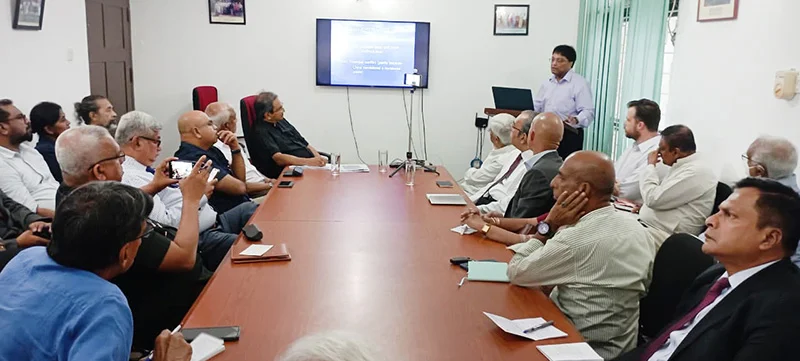
 The US-China rivalry could be said to make-up the ‘stuff and substance’ of world politics today but rarely does the international politics watcher and student of the global South in particular get the opportunity of having a balanced and comprehensive evaluation of this crucial relationship. But such a balanced assessment is vitally instrumental in making sense of current world power relations.
The US-China rivalry could be said to make-up the ‘stuff and substance’ of world politics today but rarely does the international politics watcher and student of the global South in particular get the opportunity of having a balanced and comprehensive evaluation of this crucial relationship. But such a balanced assessment is vitally instrumental in making sense of current world power relations.
Thanks to the Regional Centre for Strategic Studies (RCSS), Colombo the above window of opportunity was opened on December 8th for those sections of the public zealously pursuing an understanding of current issues in global politics. The knowledge came via a forum that was conducted at the RCSS titled, ‘The US-China Rivalry and Implications for the Indo-Pacific’, where Professor Neil DeVotta of the Wake Forest University of North Carolina in the US, featured as the speaker.
A widely representative audience was present at the forum, including senior public servants, the diplomatic corps, academics, heads of civil society organizations, senior armed forces personnel and the media. The event was ably managed by the Executive Director of the RCSS, retired ambassador Ravinatha Aryasinha. Following the main presentation a lively Q&A session followed, where many a point of interest was aired and discussed.
While there is no doubt that China is fast catching up with the US with regard to particularly military, economic, scientific and technological capability, Prof. DeVotta helped to balance this standard projection of ‘China’s steady rise’ by pointing to some vital facts about China, the omission of which would amount to the observer having a somewhat uninformed perception of global political realities.
The following are some of the facts about contemporary China that were highlighted by Prof. DeVotta:
* Money is steadily moving out of China and the latter’ s economy is slowing down. In fact the country is in a ‘ Middle Income Trap’. That is, it has reached middle income status but has failed to move to upper income status since then.
* People in marked numbers are moving out of China. It is perhaps little known that some Chinese are seeking to enter the US with a view to living there. The fact is that China’s population too is on the decline.
* Although the private sector is operative in China, there has been an increase in Parastatals; that is, commercial organizations run by the state are also very much in the fore. In fact private enterprises have begun to have ruling Communist Party cells in them.
* China is at its ‘peak power’ but this fact may compel it to act ‘aggressively’ in the international sphere. For instance, it may be compelled to invade Taiwan.
* A Hard Authoritarianism could be said to characterize central power in China today, whereas the expectation in some quarters is that it would shift to a Soft Authoritarian system, as is the case in Singapore.
* China’s influence in the West is greater than it has ever been.
The speaker was equally revelatory about the US today. Just a few of these observations are:
* The US is in a ‘Unipolar Moment’. That is, it is the world’s prime power. Such positions are usually not longstanding but in the case of the US this position has been enjoyed by it for quite a while.
* China is seen by the US as a ‘Revisionist Power’ as opposed to being a ‘Status Quo Power.’ That is China is for changing the world system slowly.
* The US in its latest national security strategy is paying little attention to Soft Power as opposed to Hard Power.
* In terms of this strategy the US would not allow any single country to dominate the Asia-Pacific region.
* The overall tone of this strategy is that the US should step back and allow regional powers to play a greater role in international politics.
* The strategy also holds that the US must improve economic ties with India, but there is very little mention of China in the plan.
Given these observations on the current international situation, a matter of the foremost importance for the economically weakest countries of the South is to figure out how best they could survive materially within it. Today there is no cohesive and vibrant collective organization that could work towards the best interests of the developing world and Dr. DeVotta was more or less correct when he said that the Non-alignment Movement (NAM) has declined.
However, this columnist is of the view that rather being a spent force, NAM was allowed to die out by the South. NAM as an idea could never become extinct as long as economic and material inequalities between North and South exist. Needless to say, this situation is remaining unchanged since the eighties when NAM allowed itself to be a non-entity so to speak in world affairs.
The majority of Southern countries did not do themselves any good by uncritically embracing the ‘market economy’ as a panacea for their ills. As has been proved, this growth paradigm only aggravated the South’s development ills, except for a few states within its fold.
Considering that the US would be preferring regional powers to play a more prominent role in the international economy and given the US’ preference to be a close ally of India, the weakest of the South need to look into the possibility of tying up closely with India and giving the latter a substantive role in advocating the South’s best interests in the councils of the world.
To enable this to happen the South needs to ‘get organized’ once again. The main differences between the past and the present with regard to Southern affairs is that in the past the South had outstanding leaders, such as Jawaharlal Nehru of India, who could doughtily stand up for it. As far as this columnist could ascertain, it is the lack of exceptional leaders that in the main led to the decline of NAM and other South-centred organizations.
Accordingly, an urgent task for the South is to enable the coming into being of exceptional leaders who could work untiringly towards the realization of its just needs, such as economic equity. Meanwhile, Southern countries would do well to, indeed, follow the principles of NAM and relate cordially with all the major powers so as to realizing their best interests.
Features
Sri Lanka and Global Climate Emergency: Lessons of Cyclone Ditwah
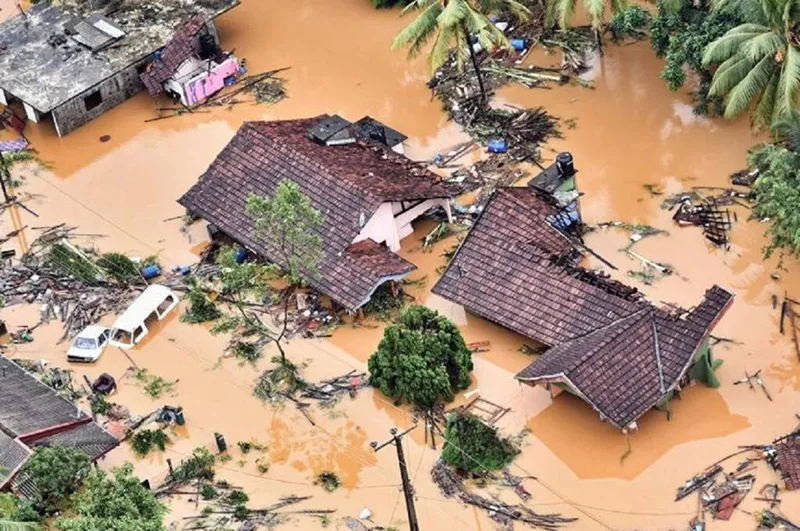
Tropical Cyclone Ditwah, which made landfall in Sri Lanka on 28 November 2025, is considered the country’s worst natural disaster since the deadly 2004 tsunami. It intensified the northeast monsoon, bringing torrential rainfall, massive flooding, and 215 severe landslides across seven districts. The cyclone left a trail of destruction, killing nearly 500 people, displacing over a million, destroying homes, roads, and railway lines, and disabling critical infrastructure including 4,000 transmission towers. Total economic losses are estimated at USD 6–7 billion—exceeding the country’s foreign reserves.
The Sri Lankan Armed Forces have led the relief efforts, aided by international partners including India and Pakistan. A Sri Lanka Air Force helicopter crashed in Wennappuwa, killing the pilot and injuring four others, while five Sri Lanka Navy personnel died in Chundikkulam in the north while widening waterways to mitigate flooding. The bravery and sacrifice of the Sri Lankan Armed Forces during this disaster—as in past disasters—continue to be held in high esteem by grateful Sri Lankans.
The Sri Lankan government, however, is facing intense criticism for its handling of Cyclone Ditwah, including failure to heed early warnings available since November 12, a slow and poorly coordinated response, and inadequate communication with the public. Systemic issues—underinvestment in disaster management, failure to activate protocols, bureaucratic neglect, and a lack of coordination among state institutions—are also blamed for avoidable deaths and destruction.
The causes of climate disasters such as Cyclone Ditwah go far beyond disaster preparedness. Faulty policymaking, mismanagement, and decades of unregulated economic development have eroded the island’s natural defenses. As climate scientist Dr. Thasun Amarasinghe notes:
“Sri Lankan wetlands—the nation’s most effective natural flood-control mechanism—have been bulldosed, filled, encroached upon, and sold. Many of these developments were approved despite warnings from environmental scientists, hydrologists, and even state institutions.”
Sri Lanka’s current vulnerabilities also stem from historical deforestation and plantation agriculture associated with colonial-era export development. Forest cover declined from 82% in 1881 to 70% in 1900, and to 54–50% by 1948, when British rule ended. It fell further to 44% in 1954 and to 16.5% by 2019.
Deforestation contributes an estimated 10–12% of global greenhouse gas emissions. Beyond removing a vital carbon sink, it damages water resources, increases runoff and erosion, and heightens flood and landslide risk. Soil-depleting monocrop agriculture further undermines traditional multi-crop systems that regenerate soil fertility, organic matter, and biodiversity.
In Sri Lanka’s Central Highlands, which were battered by Cyclone Ditwah, deforestation and unregulated construction had destabilised mountain slopes. Although high-risk zones prone to floods and landslides had long been identified, residents were not relocated, and construction and urbanisation continued unchecked.
Sri Lanka was the first country in Asia to adopt neoliberal economic policies. With the “Open Economy” reforms of 1977, a capitalist ideology equating human well-being with quantitative growth and material consumption became widespread. Development efforts were rushed, poorly supervised, and frequently approved without proper environmental assessment.
Privatisation and corporate deregulation weakened state oversight. The recent economic crisis and shrinking budgets further eroded environmental and social protections, including the maintenance of drainage networks, reservoirs, and early-warning systems. These forces have converged to make Sri Lanka a victim of a dual climate threat: gradual environmental collapse and sudden-onset disasters.
Sri Lanka: A Climate Victim
Sri Lanka’s carbon emissions remain relatively small but are rising. The impact of climate change on the island, however, is immense. Annual mean air temperature has increased significantly in recent decades (by 0.016 °C annually between 1961 and 1990). Sea-level rise has caused severe coastal erosion—0.30–0.35 meters per year—affecting nearly 55% of the shoreline. The 2004 tsunami demonstrated the extreme vulnerability of low-lying coastal plains to rising seas.
The Cyclone Ditwah catastrophe was neither wholly new nor surprising. In 2015, the Geneva-based Internal Displacement Monitoring Centre (IDMC) identified Sri Lanka as the South Asian country with the highest relative risk of disaster-related displacement: “For every million inhabitants, 15,000 are at risk of being displaced every year.”
IDMC also noted that in 2017 the country experienced seven disaster events—mainly floods and landslides—resulting in 135,000 new displacements and that Sri Lanka “is also at risk for slow-onset impacts such as soil degradation, saltwater intrusion, water scarcity, and crop failure”.
Sri Lanka ranked sixth among countries most affected by extreme weather events in 2018 (Germanwatch) and second in 2019 (Global Climate Risk Index). Given these warnings, Cyclone Ditwah should not have been a surprise. Scientists have repeatedly cautioned that warmer oceans fuel stronger cyclones and warmer air holds more moisture, leading to extreme rainfall. As the Ceylon Today editorial of December 1, 2025 also observed:
“…our monsoons are no longer predictable. Cyclones form faster, hit harder, and linger longer. Rainfall becomes erratic, intense, and destructive. This is not a coincidence; it is a pattern.”
Without urgent action, even more extreme weather events will threaten Sri Lanka’s habitability and physical survival.
A Global Crisis
Extreme weather events—droughts, wildfires, cyclones, and floods—are becoming the global norm. Up to 1.2 billion people could become “climate refugees” by 2050. Global warming is disrupting weather patterns, destabilising ecosystems, and posing severe risks to life on Earth. Indonesia and Thailand were struck by the rare and devastating Tropical Cyclone Senyar in late November 2025, occurring simultaneously with Cyclone Ditwah’s landfall in Sri Lanka.
More than 75% of global greenhouse gas emissions—and nearly 90% of carbon emissions—come from burning coal, oil, and gas, which supply about 80% of the world’s energy. Countries in the Global South, like Sri Lanka, which contribute least to greenhouse gas emissions, are among the most vulnerable to climate devastation. Yet wealthy nations and multilateral institutions, including the World Bank, continue to subsidise fossil fuel exploration and production. Global climate policymaking—including COP 30 in Belém, Brazil, in 2025—has been criticised as ineffectual and dominated by fossil fuel interests.
If the climate is not stabilised, long-term planetary forces beyond human control may be unleashed. Technology and markets are not inherently the problem; rather, the issue lies in the intentions guiding them. The techno-market worldview, which promotes the belief that well-being increases through limitless growth and consumption, has contributed to severe economic inequality and more frequent extreme weather events. The climate crisis, in turn, reflects a profound mismatch between the exponential expansion of a profit-driven global economy and the far slower evolution of human consciousness needed to uphold morality, compassion, generosity and wisdom.
Sri Lanka’s 2025–26 budget, adopted on November 14, 2025—just as Cyclone Ditwah loomed—promised subsidised land and electricity for companies establishing AI data centers in the country.
President Anura Kumara Dissanayake told Parliament: “Don’t come questioning us on why we are giving land this cheap; we have to make these sacrifices.”
Yet Sri Lanka is a highly water-stressed nation, and a growing body of international research shows that AI data centers consume massive amounts of water and electricity, contributing significantly to greenhouse gas emissions.
The failure of the narrow, competitive techno-market approach underscores the need for an ecological and collective framework capable of addressing the deeper roots of this existential crisis—both for Sri Lanka and the world.
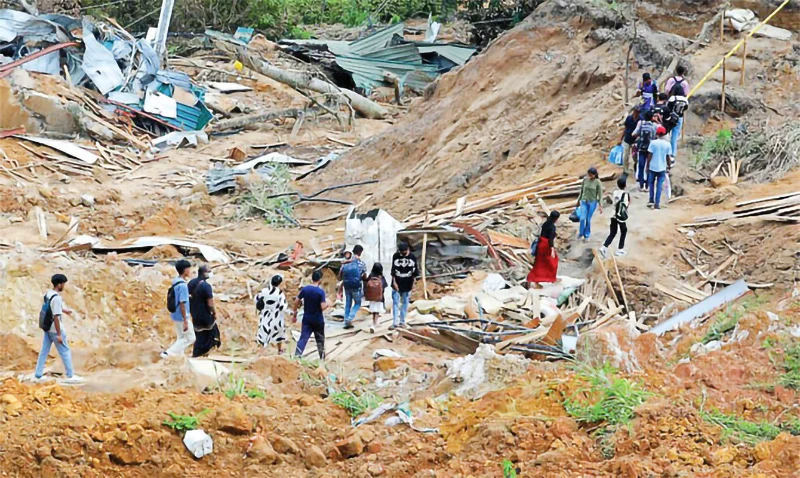
A landslide in Sri Lanka (AFP picture)
Ecological and Human Protection
Ecological consciousness demands
recognition that humanity is part of the Earth, not separate from it. Policies to address climate change must be grounded in this understanding, rather than in worldviews that prize infinite growth and technological dominance. Nature has primacy over human-created systems: the natural world does not depend on humanity, while humanity cannot survive without soil, water, air, sunlight, and the Earth’s essential life-support systems.
Although a climate victim today, Sri Lanka is also home to an ancient ecological civilization dating back to the arrival of the Buddhist monk Mahinda Thera in the 3rd century BCE. Upon meeting King Devanampiyatissa, who was out hunting in Mihintale, Mahinda Thera delivered one of the earliest recorded teachings on ecological interdependence and the duty of rulers to protect nature:
“O great King, the birds of the air and the beasts of the forest have as much right to live and move about in any part of this land as thou. The land belongs to the people and all living beings; thou art only its guardian.”
A stone inscription at Mihintale records that the king forbade the killing of animals and the destruction of trees. The Mihintale Wildlife Sanctuary is believed to be the world’s first.
Sri Lanka’s ancient dry-zone irrigation system—maintained over more than a millennium—stands as a marvel of sustainable development. Its network of interconnected reservoirs, canals, and sluices captured monsoon waters, irrigated fields, controlled floods, and even served as a defensive barrier. Floods occurred, but historical records show no disasters comparable in scale, severity, or frequency to those of today. Ancient rulers, including the legendary reservoir-builder King Parākramabāhu, and generations of rice farmers managed their environment with remarkable discipline and ecological wisdom.
The primacy of nature became especially evident when widespread power outages and the collapse of communication networks during Cyclone Ditwah forced people to rely on one another for survival. The disaster ignited spontaneous acts of compassion and solidarity across all communities—men and women, rich and poor, Buddhists, Christians, Muslims, and Hindus. Local and international efforts mobilized to rescue, shelter, feed, and emotionally support those affected. These actions demonstrated a profound human instinct for care and cooperation, often filling vacuums left by formal emergency systems.
Yet spontaneous solidarity alone is insufficient. Sri Lanka urgently needs policies on sustainable development, environmental protection, and climate resilience. These include strict, science-based regulation of construction; protection of forests and wetlands; proper maintenance of reservoirs; and climate-resilient infrastructure. Schools should teach environmental literacy that builds unity and solidarity, rather than controversial and divisive curriculum changes like the planned removal of history and introduction of contested modules on gender and sexuality.
If the IMF and international creditors—especially BlackRock, Sri Lanka’s largest sovereign bondholder, valued at USD 13 trillion—are genuinely concerned about the country’s suffering, could they not cancel at least some of Sri Lanka’s sovereign debt and support its rebuilding efforts? Addressing the climate emergency and the broader existential crisis facing Sri Lanka and the world ultimately requires an evolution in human consciousness guided by morality, compassion, generosity and wisdom. (Courtesy: IPS NEWS)
Dr Asoka Bandarage is the author of Colonialism in Sri Lanka: The Political Economy of the Kandyan Highlands, 1833-1886 (Mouton) Women, Population and Global Crisis: A Politico-Economic Analysis (Zed Books), The Separatist Conflict in Sri Lanka: Terrorism, Ethnicity, Political Economy, ( Routledge), Sustainability and Well-Being: The Middle Path to Environment, Society and the Economy (Palgrave MacMillan) Crisis in Sri Lanka and the World: Colonial and Neoliberal Origins, Ecological and Collective Alternatives (De Gruyter) and numerous other publications. She serves on the Advisory Boards of the Interfaith Moral Action on Climate and Critical Asian Studies.
Features
Cliff and Hank recreate golden era of ‘The Young Ones’

 Cliff Richard and Hank Marvin’s reunion concert at the Riverside Theatre in Perth, Australia, on 01 November, 2025, was a night to remember.
Cliff Richard and Hank Marvin’s reunion concert at the Riverside Theatre in Perth, Australia, on 01 November, 2025, was a night to remember.
The duo, who first performed together in the 1950s as part of The Shadows, brought the house down with their classic hits and effortless chemistry.
The concert, part of Cliff’s ‘Can’t Stop Me Now’ tour, featured iconic songs like ‘Summer Holiday’, ‘The Young Ones’, ‘Bachelor Boy’, ‘Living Doll’ and a powerful rendition of ‘Mistletoe and Wine.’
Cliff, 85, and Hank, with his signature red Fender Stratocaster, proved that their music and friendship are timeless.
According to reports, the moment the lights dimmed and the first chords of ‘Move It’ rang out, the crowd knew they were in for something extraordinary.
Backed by a full band, and surrounded by dazzling visuals, Cliff strode onto the stage in immaculate form – energetic and confident – and when Hank Marvin joined him mid-set, guitar in hand, the audience erupted in applause that shook the hall.
Together they launched into ‘The Young Ones’, their timeless 1961 hit which brought the crowd to its feet, with many in attendance moved to tears.
The audience was treated to a journey through time, with vintage film clips and state-of-the-art visuals adding to the nostalgic atmosphere.
Highlights of the evening included Cliff’s powerful vocals, Hank’s distinctive guitar riffs, and their playful banter on stage.

Cliff posing for The Island photographer … February,
2007
Cliff paused between songs to reflect on their shared journey saying:
“It’s been a lifetime of songs, memories, and friendship. Hank and I started this adventure when we were just boys — and look at us now, still up here making noise!”
As the final chords of ‘Congratulations’ filled the theatre, the crowd rose for a thunderous standing ovation that lasted several minutes.
Cliff waved, Hank gave a humble bow, and, together, they left the stage, arm-in-arm, to the refrain of “We’re the young ones — and we always will be.”
Reviews of the show were glowing, with fans and critics alike praising the duo’s energy, camaraderie, and enduring talent.
Overall, the Cliff Richard and Hank Marvin reunion concert was a truly special experience, celebrating the music and friendship that has captivated audiences for decades.
When Cliff Richard visited Sri Lanka, in February, 2007, I was invited to meet him, in his suite, at a hotel, in Colombo, and I presented him with my music page, which carried his story, and he was impressed.
In return, he personally autographed a souvenir for me … that was Cliff Richard, a truly wonderful human being.
-

 News3 days ago
News3 days agoOver 35,000 drug offenders nabbed in 36 days
-

 Business5 days ago
Business5 days agoLOLC Finance Factoring powers business growth
-

 News2 days ago
News2 days agoCyclone Ditwah leaves Sri Lanka’s biodiversity in ruins: Top scientist warns of unseen ecological disaster
-

 News5 days ago
News5 days agoCPC delegation meets JVP for talks on disaster response
-

 News5 days ago
News5 days agoA 6th Year Accolade: The Eternal Opulence of My Fair Lady
-

 Features1 day ago
Features1 day agoFinally, Mahinda Yapa sets the record straight
-

 News3 days ago
News3 days agoRising water level in Malwathu Oya triggers alert in Thanthirimale
-
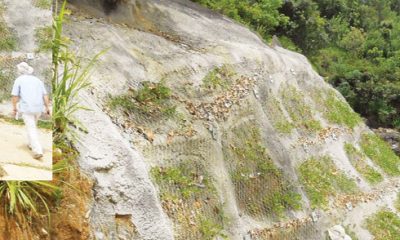
 Features4 days ago
Features4 days agoThe Catastrophic Impact of Tropical Cyclone Ditwah on Sri Lanka:













